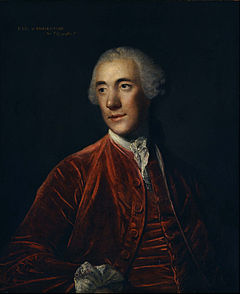Robert Darcy, 4th Earl of Holderness
Robert Darcy, 4th Earl of Holderness, PC (17 May 1718 – 16 May 1778), known before 1721 as Lord Darcy and Conyers, was a British diplomat and politician.[1][2]
The Earl of Holderness | |
|---|---|
 | |
| Secretary of State for the Southern Department | |
| In office 6 April 1757 – 27 June 1757 | |
| Monarch | George II |
| Preceded by | William Pitt |
| Succeeded by | William Pitt |
| In office 18 June 1751 – 23 March 1754 | |
| Monarch | George II |
| Preceded by | The Duke of Bedford |
| Succeeded by | Thomas Robinson |
| Secretary of State for the Northern Department | |
| In office 23 March 1754 – 25 March 1761 | |
| Monarchs | George II George III |
| Preceded by | The Duke of Newcastle |
| Succeeded by | The Earl of Bute |
| Personal details | |
| Born | 17 May 1718 |
| Died | 16 May 1778 (aged 59) Syon Hill, London, England |
| Nationality | Great Britain |
| Spouse | Mary Doublet |
| Children | Amelia Osborne, Marchioness of Carmarthen |
| Parent(s) | Robert Darcy, 3rd Earl of Holderness Lady Frederica Schomberg |
| Occupation | Diplomat, politician |
Career
editIn 1741 he collaborated with G.F. Handel in the production of Deidamia.[3] From 1744 to 1746 he was ambassador at Venice and from 1749 to 1751 he represented his country at The Hague. In 1751 he became Secretary of State for the Southern Department, transferring in 1754 to the Northern Department, and he remained in office until March 1761, when he was dismissed by King George III in favour of Lord Bute, although he had largely been a cipher in that position to the stronger personalities of his colleagues, successively the Duke of Newcastle, Thomas Robinson, Henry Fox, and William Pitt the Elder. From 1771 to 1776 he acted as governor to two of the King's sons, a solemn phantom as Horace Walpole calls him. He left no sons who survived childhood,[2] and all his titles became extinct except the Baronies of Darcy de Knayth and Conyers, which were baronies by writ inherited from his father, and the Portuguese countship of Mértola, inherited from his mother. In those peerages, he was succeeded by his daughter, Amelia Osborne, Marchioness of Carmarthen.
David Hume wrote, "It is remarkable that this family of d'Arcy [sic] seems to be the only male descendant of any of the Conqueror's barons now remaining among the Peers. Lord Holdernessae [sic] is the heir of that family".[4]
Family
editHe was the only surviving son of Robert Darcy, 3rd Earl of Holderness, and his wife Lady Frederica Schomberg. On 29 October 1743, Darcy married Mary Doublet, daughter of Francis Doublet and Constantia Van-der-Beck. The couple had three children, only one of whom survived childhood:[2]
- George Darcy, Lord Darcy and Conyers (September 1745 – 27 September 1747)
- Thomas Darcy, Lord Darcy and Conyers (born and died 1750), buried 29 July 1750 in the Great or St. James Church in The Hague, the Netherlands[5]
- Lady Amelia Darcy (12 October 1754 – 27 January 1784); married firstly Francis Osborne, Marquess of Carmarthen, and had issue. The couple divorced in 1779. She married secondly John "Mad Jack" Byron, father of Lord Byron, and had one daughter, Augusta Leigh.
See also
editReferences
edit- ^ . Dictionary of National Biography. London: Smith, Elder & Co. 1885–1900.
- ^ a b c Record for Robert Darcy, 4th Earl of Holderness on thepeerage.com
- ^ A New Chronology of Venetian Opera and Related Genres, 1660-1760 by Eleanor Selfridge-Field, p. 492
- ^ History of England (Chicago: University of Chicago Press, 1975), p. 16 n. 14.
- ^ Wildeman, Marinus Godefridus, De grafboeken der Groote of St. Jacobskerk te 's Gravenhage, (1620-1830)... Robijns Publishers, 1898